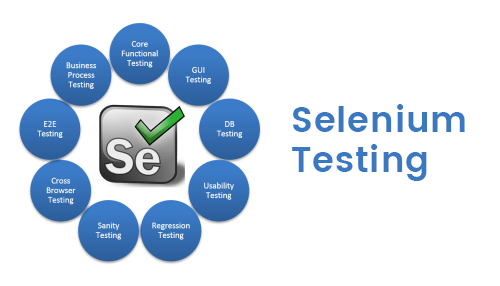Testing is the most important phase in the software development lifecycle (SDLC). The main objective of testing is to ensure bug-free software that will meet customers’ requirements. Sometimes testing can be strenuous as it involves manual test case execution against various applications to detect and fix errors.
But what if we could automate the whole testing procedure which would make it less monotonous? Selenium does exactly that.
Selenium is a portable framework for web application testing. It authorizes functional tests without learning the test scripting language.
It also provides a test-domain specific language to write tests in several popular programming languages, including PHP, Perl, C#, Java, Groovy, Scala, and Ruby. Cross-browser automation testing Selenium is an effective testing method used by testers and the tool is also used for web application testing. This Selenium tool consists of several components – Selenium IDE, Selenium Grid, Selenium RC, Selenium WebDriver that provide different features.
WHY SELENIUM AUTOMATION TESTING?
OdiTek’s test automation leverages Selenium as the preferred choice of tool for web application automated testing, function regression automation testing, and developing and maintaining automated test suites. Our Selenium test automation framework is used for cross-platform application testing of mobile and web applications. With Selenium WebDriver as the engine, we implement custom solutions to function with various lifecycle tools, ensuring seamless integration.
AUTOMATION SELENIUM TESTING CHALLENGES & SOLUTIONS
Selenium has made web app testing simpler for many of the enterprises and QA teams worldwide. But the testing tool has a fair share of challenges too. However, most of the issues faced by the testers have clear-cut solutions. This is the reason we’ve summarized some of the common Selenium automation testing challenges and their solutions.
So, let’s get started.
1.Mobile Application Testing
When using Selenium, we can build automated test cases on any browser and operating system on the desktop, however, we cannot perform mobile tests with Selenium simultaneously.
Solution: You can make use of tools like Appium mobile application automation tool to handle iOS and Android applications using the WebDriver protocol. As there is more number of users opting for mobile devices, it is no surprise that the developers and testers are taking benefits of Appium’s functionalities for this purpose.
2.REPORTING:
Reporting is a major challenge faced during automation testing Selenium, as the tool does not support reporting on its own. You can use various packages or third-party tools like Pytest, TestNG, etc. However, these options will require you to have advanced programming skills.
Solution: You can use TestProject to create detailed reports on the fly, without the need to explicitly mention any of the reporting steps in your Selenium code or recordings, and without requiring any additional tools. You will get in-depth reports with all the necessary insights and trends needed to troubleshoot your automation testing and measure the product’s quality.
3.Page Load:
Some pages load various elements depending upon the users’ distinct behavior and journey. Sometimes it results in view-based past actions that the user makes. For example, if you choose a nation from dropdown lists, then the cities related to that particular nation will load in the dropdown. While executing the automation testing Selenium, the script might not be able to trace the element.
Solution: To resolve this, use explicit waits in the Selenium script to provide elements with sufficient time to upload and locate the element. You can check out TestProject’s adaptive wait capability to avoid any test flakiness.
4.Desktop Application Testing:
As Selenium does not support windows-based desktop testing, this was one of the primary challenges faced. Selenium supports only web-based applications.
Solution: We need to remember that Selenium cannot automate every single task. So, it is crucial to have a thorough understanding of the programming languages for using Selenium.
5.Scalability:
Even though Selenium gives you the flexibility to test on any operating system or browser, it is still restricted to the number of tests it can perform at once and how quickly it can perform them. Without a Selenium Grid, you can only execute one test after the other. It can scale your test procedure with the use of remote WebDrivers, and enable running test cases in parallel. But you cannot test your web application across multiple OS and browsers. The test cases can only be executed on a specific browser and OS at a time.
Solution: You can use cloud-testing applications to test your apps across multiple browsers and OS all at the same time.
CONCLUSION
Automation testing with Selenium can be tricky, but it is without a doubt the king of web testing. While automated test cases allow for quick identification and resolution of problems within an applications’ codebase, the challenges are not that easy to be tackled. Thus, additional methods or tools should be considered and implemented accordingly.
Test automation can quickly get out of hand if there is not a proper way to organize, schedule, execute tests, and report results across tools. OdiTek’s integration with Selenium automation brings much-needed peace to the test automation chaos. We help customers to jumpstart their automation efforts and implement a proven platform to reduce maintenance and increase longevity. We have a dedicated team of Selenium test automation experts with extensive experience in Selenium browser testing for applications of all sizes.







